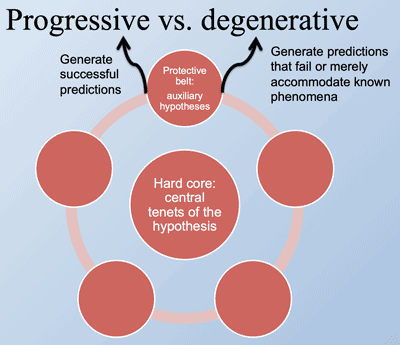 |
Imre Lakatos’s methodology of scientific research programmes & the mantle plume hypothesis |
Thomas Rossetter
Department of Philosophy, Durham University, Durham, U.K., thomas.rossetter@durham.ac.uk
The following conference presentation included material based on this webpage:
Foulger, G.R. & T. Rossetter, Do Mantle Plumes Exist?, Abstract 95-2, Geological Society of America Annual Meeting, Phoenix, AZ, 22-25 September, 2019.
To access the Powerpoint presentation, click here.
The first serious theory of scientific method in contemporary philosophy of science was Karl Popper’s falsificationism. According to Popper (1959, 1934), scientists formulate hypotheses and subject them to stringent tests essentially by attempting to falsify them. They use hypotheses to make risky predictions about phenomena that should be observed if a hypothesis is correct. If a prediction fails, then the hypothesis is falsified. This, in Popper’s view is what distinguishes serious scientific theories such as general relativity from pseudo-scientific theories such as Freudian psychoanalysis and Marxist history. The reasoning of scientists on this view has the following logical form:

(Click here for explanation of logic symbols.)
If the hypothesis H is true, then the phenomenon P will be observed. P was not observed. Therefore, H is false.
Popper’s falsificationism, however, is flawed, both logically and historically. As Pierre Duhem (1954, 1914) and Willard Van Orman Quine (1951) pointed out, hypotheses cannot be tested in isolation but only in conjunction with numerous other auxiliary assumptions. So a failed prediction can never conclusively falsify a hypothesis. In this view, the logical form of scientific reasoning is as follows:

If the hypothesis H and the auxiliary assumptions a1– an are true, then the phenomenon P will be observed. P was not observed. Therefore, either H , or a1 , or a2 , or a3 , or …, or an is false. The failed prediction shows only that either the hypothesis or one or more of the auxiliary assumptions is false.
As Thomas Kuhn (1962) showed, if we look at the history of science, we find that this is precisely the kind of reasoning that scientists employ. When faced with a failed prediction, moreover, rather than rejecting the hypothesis, scientists typically reject one of their auxiliary assumptions. When Uranus’s orbit was not as predicted by classical mechanics, for example, rather than rejecting the hypothesis of classical mechanics, scientists rejected an auxiliary assumption about the number of planets in the solar system (i.e., the assumption that there were only 7 planets).
Imre Lakatos (1970) essentially combined Popper’s emphasis on testing and prediction, Duhem’s and Quine’s analysis of scientific reasoning, and Kuhn’s historical observations of scientific practice into a sophisticated “methodology of scientific research programmes”. Contrary to Kuhn, who maintained that scientific disciplines are dominated by a single paradigm, Lakatos argued that they consist rather of a number of competing research programmes. A research programme consists essentially of two components. First, a “hard core”: the central tenets of the hypothesis which are effectively immune from falsification. Second, a “protective belt”: a set of auxiliary hypotheses which are introduced at different times to accommodate predictive failures (Figure 1).
.

Figure 1: Lakatos model of scientific research programmes.
.
Such a methodology seems reasonable, since we want to protect our hypotheses against false negatives. It would have been wrong for scientists to reject classical mechanics because of its failed prediction about Uranus, since the failure was due not to the falsity of classical mechanics but to a mistaken auxiliary assumption about the number of planets in the solar system. By introducing the auxiliary hypothesis that there is another planet beyond Uranus into the protective belt, scientists could accommodate the failed prediction without rejecting the hard core of the programme.
Lakatos distinguished between scientific research programmes that are “progressive” and those that are “degenerative” on the following basis. A research programme is progressive if the auxiliary hypotheses that are introduced into the protective belt are used to make successful predictions, for these predictions corroborate both the auxiliary hypothesis and the hard core of the programme. In the case of classical mechanics and Uranus, the auxiliary hypothesis together with the hard core of the programme was used to successfully predict the mass and position of an eighth planet, Neptune. At this time, then, classical mechanics, in Lakatos’s view, constituted a progressive research programme.
A research programme is degenerative if the auxiliary hypotheses introduced to accommodate failed predictions merely explain known phenomena (i.e., the failed predictions) or if their predictions fail. Here again, classical mechanics provides an instructive example. Later in the nineteenth century when it was discovered that the precession of Mercury's perihelion is not as predicted by classical mechanics, an auxiliary hypothesis that there is another planet orbiting between Mercury and the Sun was introduced. Predictions about this hypothetical planet – Vulcan – failed, and later auxiliary hypotheses introduced to accommodate the phenomenon – such as the Sun’s mass being inhomogeneous – lacked predictive power. At this point, in Lakatos’s view, the programme had begun to degenerate, and it was not until it was superseded by a new, progressive research programme – general relativity – that Mercury’s perihelion could be successfully accounted for.
Lakatos’s methodology of scientific research programmes may be useful for examining the mantle plume hypothesis. Though often referred to in the scientific literature in Kuhnian terms as a “paradigm”, the plume hypothesis may be better characterised as a Lakatosian research programme (with the rival plate hypothesis constituting a competing research programme). The hypothesis consists of a hard core, the central tenets of the hypothesis which are effectively immune from falsification, and a protective belt, an increasing set of auxiliary hypotheses introduced to accommodate failed predictions. Analysing the plume hypothesis in such terms raises the following questions:
- What constituents of the plume hypothesis constitute the hard core of the research programme?
- What are the auxiliary hypotheses that make up the protective belt?
And most importantly,
- Is the plume hypothesis a progressive or a degenerative research programme in the Lakatosian sense? That is, have the auxiliary hypotheses introduced into the protective belt been used to make successful predictions or do they either make unsuccessful predictions or merely accommodate known phenomena?
References
- Duhem, P. (1954 [first published in French 1914]). The aim and structure of physical theory, second edition. Princeton: Princeton University Press.
- Kuhn, T. S. (1962). The structure of scientific revolutions. Chicago, IL.: University of Chicago Press.
- Popper (1959 [first published in German 1935]). The logic of scientific discovery. London: Routledge.
- Quine, W. V. O. (1951). Two dogmas of empiricism. The Philosophical Review, 60, 20-43.
- Lakatos, I. (1970). Falsification and the methodology of scientific research programmes. In I. Lakatos & A. Musgrave (Eds.), Criticism and the growth of knowledge (pp. 91-196). Cambridge: Cambridge University Press.
last updated 12th
October, 2019 |
